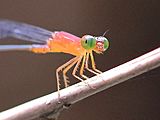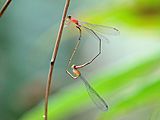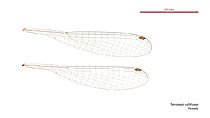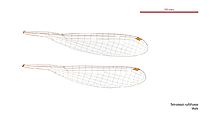Red-breasted longtail facts for kids
Quick facts for kids Red-breasted longtail |
|
|---|---|
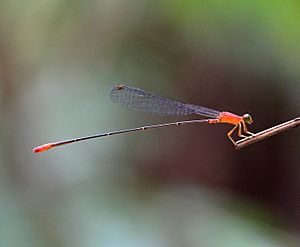 |
|
| Male, Cairns | |
| Conservation status | |
| Scientific classification | |
 |
The Red-breasted longtail (scientific name: Teinobasis rufithorax) is a fascinating type of damselfly. Damselflies are delicate insects that are related to dragonflies. They are part of a group called Odonata, which means "toothed ones," referring to their strong jaws. This damselfly is known for its bright colors and slender body.
Contents
What is a Damselfly?
Damselflies are insects that spend part of their lives in water. They have two pairs of strong, clear wings. Unlike dragonflies, damselflies usually hold their wings together over their back when they are resting. They also have thinner bodies and their eyes are usually spaced far apart.
The Red-breasted longtail belongs to the family Coenagrionidae. This family includes many small to medium-sized damselflies. They are often found near still or slow-moving water.
Where Does the Red-breasted Longtail Live?
This colorful damselfly is found in several parts of the world. You can spot it in Australia, especially on the Cape York Peninsula in Queensland, and on the Torres Strait islands.
It also lives in other areas like the Maluku Islands, Aru Islands, and the large island of New Guinea. You can find it in the Bismarck Archipelago and the Solomon Islands too. These places are often warm and have lots of water.
The Red-breasted longtail prefers to live near shaded, deep waters. This means you might find them near quiet ponds, slow rivers, or even swamps where there's plenty of shade from trees.
What Does it Look Like?
The Red-breasted longtail is a medium-sized damselfly. It has a bright orange body, which makes it easy to spot. One of its most distinctive features is the orange-red tip on its tail. This gives it the "red-breasted" part of its common name.
Like all damselflies, it has long, clear wings that help it fly quickly and gracefully. Its slender body and vibrant colors make it a beautiful insect to observe in its natural habitat.
Gallery




